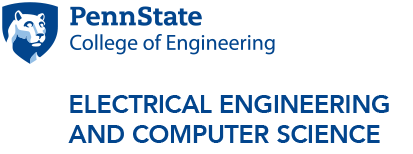
Organic light-emitting diode luminaires produced by OLEDWorks LLC. The new DOE-funded project between Penn State and OLEDWorks aims to increase the amount of light extracted from luminaires like these ones, boosting their efficiency well beyond that of fluorescent lamps. IMAGE: OLEDWORKS
Engineering professor awarded $1.1M grant to increase efficiency of organic LEDs
6/18/2019
By Sarah Small
UNIVERSITY PARK, Pa. — Chris Giebink, associate professor of electrical engineering at Penn State, has been awarded a two-year, $1.1 million grant from the U.S. Department of Energy for his research in organic light-emitting diodes (OLEDs).
The research, which is being conducted in conjunction with Michael Hickner, professor of materials science and engineering, chemical engineering, and chemistry, is focused on increasing the efficiency of OLEDs used for room lighting.
“Because this is a two-year grant, the research is fast-paced and intense,” Giebink said. “The product of this particular grant ideally will be something that we translate into commercial production with our industry partner, OLEDWorks. This gives us the chance to have real-world impact in the near term, which would be gratifying.”
Organic LEDs are made of very thin films of molecules, as opposed to inorganic LEDs, which are made out of inorganic semiconductors such as gallium nitride. While organic LEDs produce light very efficiently, most of the produced light doesn’t actually make it out of the device.
“Right now, only about 20 percent of the light that’s generated in OLEDs gets out,” said Giebink. “The rest is trapped in the device and wasted.”
Overcoming this challenge could make OLEDs more than twice as efficient as the fluorescent lamps currently used in buildings.
Over the past 10 years, there have been many approaches for extracting the remaining light out of OLEDs, but so far, no one has been able to do so in a way that’s manufacturable.
“We can implement solutions in the lab at a size of about a millimeter by a millimeter, but doing it on a scale of meters in a way that’s actually compatible with manufacturing is the real challenge,” Giebink said. “That’s where our project comes in. We’re not trying to scatter the light out. We’re actually changing the makeup of the organic semiconductors to change their refractive index, which is an indication of how fast light propagates in a material. What we’re trying to do is lower that value in the organic materials that make up the OLED because, if we can, it’ll avoid much of the problem to begin with.”
The difficulty with this approach is that trying to change the refractive index of the materials themselves may negate the molecules’ electrical and luminescent properties, which took 10 to 15 years of design work to achieve.
“But what we found is that if you take other molecules and blend those in, you can decrease the refractive index of the entire film without adversely affecting the properties of the original molecules,” said Giebink. “We blend in spectators that will change the optical properties but not the electrical properties.”
If Giebink and his fellow researchers can blend these molecules effectively, they will work with OLEDWorks to see if they can scale up the work to be manufactured.
Should the researchers reach the point of commercialization, it would not be their first successful experience with seeing their research incorporated into a commercial product.
“We had another similar program before, focused on white OLED panels where we also worked with the same arm of the DOE and with OLEDWorks,” Giebink said. “That was focusing on a very different question of the long-term reliability of these panels. Sometimes they’d fail catastrophically halfway through their life, and we wanted to figure out why that was happening and how to prevent it from happening. Turns out we were successful in figuring out the problem and coming up with a solution that OLEDWorks is now using in their products.”
With this newer OLED research, Giebink and his colleagues are optimistic about the chances of repeating their success. If they do, the environmental implications of their work on a commercial-scale are significant.
“The efficiency of organic LEDs commercially right now is something like 70 to 80 lumens per watt. For comparison, your standard incandescent lightbulb is a little bit less than 20. So, we’re talking about four times the efficiency,” Giebink said. “That’s a big opportunity for energy savings that complements what inorganic LEDs are able to provide.”
Giebink credits the resources and people at Penn State as instrumental in both receiving the grant and conducting the research.
“Being at Penn State is really useful from a materials standpoint because we have a fantastic materials characterization facility. There was never a question about whether or not we could do this research because we have every tool we could possibly want here,” Giebink said. “Also, the people we have here are great. When I realized what we needed in terms of someone to design the molecules in order to make this idea work, it was just a matter of walking across one building in order to find Mike who said, ‘Yeah, we can do that.’ It’s a collection of facilities and people that I think is really the enabling factor.”




